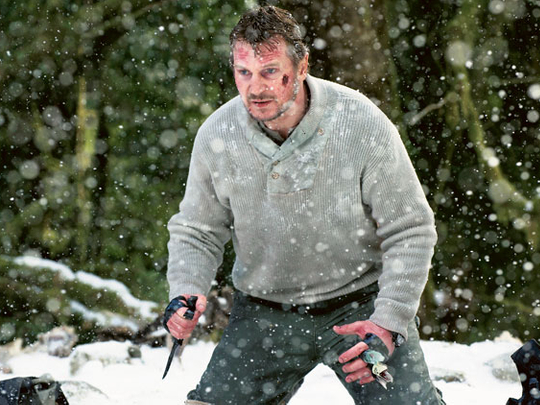
In the opening scenes of The Grey, Liam Neeson's character explains in a letter to his dead wife that the dull ache of his grief has taken him to the frigid ends of the earth and put him in the company of desperate and empty men.
It's difficult to watch Neeson trudge through snow and heartache at the start of the film and not think about the actor's own ordeals — it will be three years ago this March that his wife, actress Natasha Richardson, suffered a fatal head injury during ski lessons at the Mont Tremblant Resort in Quebec.
The general opinion in Hollywood is that Neeson has tried in recent seasons to lose himself amid the sound of action-movie explosions — he starred in The A-Team as well as the upcoming films Wrath of the Titans and Battleship — but The Grey actually challenges that view. This movie is an unblinking study of loss, not a distraction from it.
"I've seen the film twice now and what I like about my guy is that he knows that he's looking into the abyss but he keeps putting one foot in front of the other," Neeson said on a recent afternoon in Los Angeles.
"He's not curling up like a foetus. There's hope or, at least, there's determination."
The movie, directed and co-written by Joe Carnahan, stars Neeson as John Ottway, a widower who takes a job as a sharpshooter for an oil company — it's his task to shoot the wolves and bears that menace Alaska pipeline workers — but the job may just be an attempt at suicide by adventure.
Calamity
Ottway is an outsider among the hard-eyed and hard-drinking workers, but he finds himself leading an unexpected tribe after a calamity; a small commercial flight carrying pipeline employees and Ottway back to civilisation crashes and the survivors find themselves at odds with the elements, their own fears and, worst of all, a pack of snarling wolves defending their territory.
"The script read like a 19th century epic poem, like The Rime of the Ancient Mariner," Neeson said. "That touched every button for me. Every movie I got to, there's someone on a cellphone, there's someone on a computer, there's someone texting, and that's how you're told the story. Look, there's not a car in this movie. This is real moviemaking, man versus man, man versus nature."
The Grey, which is being released from upstart distributor OpenRoad Films, is not for people who fear heights, dogs or air travel — and, reading the script, Neeson said his most pressing concern was his ability to endure the 40-day shoot in Smithers, British Columbia, where temperatures would drop 30 degrees below zero.
The blizzards seen in the film are entirely real — there is no CG-created weather on screen — and the 59-year-old actor said he had his doubts that his bad knees could handle it.
"The blizzards, everything, all the snow and sleet, all of it was real, it's the nature," Neeson said. "There was no CGI, we went right through the stuff that came at us. It was one year ago today we were out there doing it, and I still can't believe we finished the film. It's the first time in my career — and I've made 55 films now — where I thought, ‘We will not finish this film, this film will finish us. Something bad is going to happen.'"
The film was inspired by a short story, The Ghost Walker by Ian Mackenzie Jeffers, and Carnahan spent years carrying the project in the back pocket of his career. The film and its Jack London soul feels like a departure for the director of Narc, Smokin' Aces and The A-Team, but he says it's his most personal project.
"It's a survival tale, so in a way those are almost plotless exercises — you either are going to make it or you ain't," Carnahan said.
"The characters are set upon by the forces of nature, and in that you can explore the things that truly vex all of us — our mortality, our purpose on this earth, God and faith, all of these things. Sometimes with material like this, if you listen to it, it will tell you what it wants to be.
"I spent a lot of years working and toiling away on it until it got to a point where I had grown up enough as a man and as a father to make a movie that might be all of those things and wouldn't just vanish," he added.
Carnahan wanted a cast of relative unknowns to heighten the feeling of vulnerability, and he found them in Frank Grillo, Dallas Roberts, Joe Anderson and Nonso Anozie. Only Neeson and Dermot Mulroney are familiar faces, and the latter, beneath a beard and glasses, won't be easily recognised by most moviegoers.
Neeson's A-Team co-star Bradley Cooper was planning to star at one point, but Carnahan said the older actor "and the life experience written in his face" was better suited to the fierce tale.
Carnahan set up a screening of Raging Bull for his actors and handed each a copy of James Dickey's 1970 novel Deliverance, which presents a similar tale of a band of men fighting to survive in cruel conditions and find their way home.
Rigours
The cast members say they became truly bonded during the rigours of the shoot and, despite lost fingernails and frostbite scars, came back from the mountain top feeling a warm connection to one another.
"Working with Liam was like getting to play baseball with Mickey Mantle," Grillo said with an admiring chuckle. "The best thing is, he showed up and insisted on being one of the guys. There was never any movie-star pretence. And he could not be more different than his characters, he's a very gentle guy ... we went to a football game together after we got back and he brought a book and I said to him, ‘Liam you can't read Shakespeare at a Jets game.'"
After the box-office success of Pierre Morel's 2008 thriller Taken, Neeson has become— in the eyes of film fans — a sort of latter-day Clint Eastwood or Charles Bronson.
Some of those moviegoers will be surprised when they sit down in the dark with The Grey, but Carnahan said his leading man is on a complicated journey as an actor these days.
"The tragedies we go through in life, whatever they do to alter our being, that's just naturally brought to bear on everything that comes after," Carnahan said.
"If you're in touch with that or in tune with who you are — creatively, artistically — it becomes part of your expression. For a creative person, it's there in their work and their choices, if they can be honest about it. "Liam," he added, "is nothing if not brutally, brilliantly sincere and honest."
— Los Angeles Times










